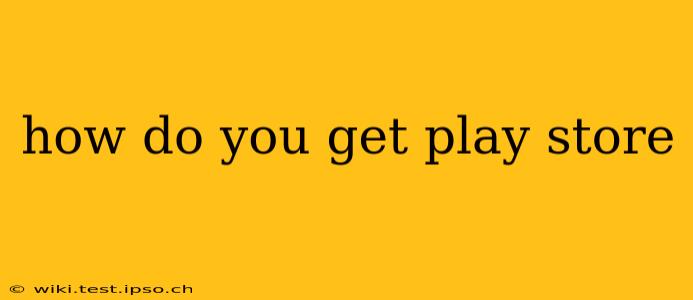How to Get the Google Play Store: A Comprehensive Guide
The Google Play Store is the go-to app marketplace for Android devices, offering a vast library of apps, games, movies, books, and more. Getting access is usually straightforward, but some situations require extra steps. This guide covers various scenarios and troubleshooting tips.
1. For Most Android Devices:
The Google Play Store is pre-installed on almost all Android devices. If you've just bought a new Android phone or tablet, it should be readily available in your app drawer (the screen where all your apps are listed). Look for an icon that typically resembles a colorful triangle-shaped play button. Simply tap the icon to open the store.
2. If the Google Play Store is Missing:
If you can't find the Play Store on your Android device, several factors could be at play:
-
Factory Reset: A factory reset can sometimes inadvertently remove the Play Store. If you've recently performed a factory reset, you'll likely need to set up your device again. During setup, you'll be prompted to sign in with your Google account, which should automatically reinstall the necessary Google apps, including the Play Store.
-
Device Issues: In rare cases, a malfunctioning device might prevent the Play Store from functioning correctly. If you suspect a hardware problem, contacting your device's manufacturer or seeking professional repair is advisable.
-
Custom ROMs: If your Android device is running a custom ROM (a modified version of Android), the Play Store might not be included. Custom ROMs often require manual installation of Google services through a process called "GApps." Search online for instructions specific to your ROM and device model. This requires technical proficiency.
-
Rooted Devices: Rooting your Android device, while offering increased control, can sometimes interfere with Google services. Similar to custom ROMs, you may need to reinstall Google services. Again, this involves technical expertise and may void your warranty.
3. For Amazon Fire Tablets:
Amazon Fire tablets don't come with the Google Play Store pre-installed. However, you can install it through a process called "sideloading," which involves downloading and installing the Play Store APK file (the installation package). This requires enabling "developer options" and "unknown sources" on your Fire tablet. We strongly advise researching the specific steps carefully online before attempting this process, as incorrect installation can lead to issues. Note that this procedure might void your warranty.
4. Troubleshooting the Google Play Store:
If the Play Store is there but not functioning correctly, try these steps:
-
Check your internet connection: A stable internet connection is crucial. Try connecting to Wi-Fi or ensuring a strong cellular signal.
-
Clear the Play Store cache and data: Go to your device's settings, find the app manager or app info, select the Google Play Store, and clear the cache and data. This will reset the app to its default state and can resolve temporary issues.
-
Restart your device: A simple restart often resolves temporary glitches.
-
Update the Play Store: Check for Play Store updates through the device's settings.
-
Check for Google Services updates: Google Play services are necessary for the Play Store to work. Ensure these are up-to-date.
5. How to Use the Google Play Store Once Installed:
Once you have access to the Google Play Store, using it is intuitive:
-
Sign in with your Google Account: You'll need a Google account to download apps and access features.
-
Search for apps: Use the search bar to find apps, games, movies, books, etc.
-
Browse categories: Explore various categories to discover new content.
-
Download and install apps: Tap the "Install" button to download and install the chosen apps.
By following these steps and troubleshooting tips, you should be able to successfully obtain and use the Google Play Store on your Android device. Remember to always exercise caution when installing apps from unofficial sources, as these might contain malware.
